Thailand First-Time Travel: Avoid Common Mistakes!
Did you know over 39 million tourists visited Thailand in 2019? It’s a top destination with rich culture, tasty food, and beautiful beaches. As a first-time traveller to Thailand, you’re probably excited but a bit nervous.

To have a great trip, being prepared is key. With some Thailand travel tips, you can enjoy your journey without worries. This guide will help you make your Thailand first-time travel experience unforgettable.
Understanding Thailand’s Culture and Customs
Traveling to Thailand means learning about its culture and customs. This knowledge helps you have a respectful and fun trip. Thai people are welcoming to tourists, even if they don’t know they’re making a mistake.
It’s important to know about Thailand’s unique cultural norms. This way, you can show respect and enjoy your visit more.
Respecting Local Traditions
Thailand values its history and traditions deeply. Showing respect for the monarchy and Buddhism is key. Avoid making negative comments about these.
Some traditions to keep in mind include:
- Removing your shoes before entering temples or homes
- Not touching or handling Buddha images or other sacred objects
- Participating in local ceremonies or festivals with respect and an open mind
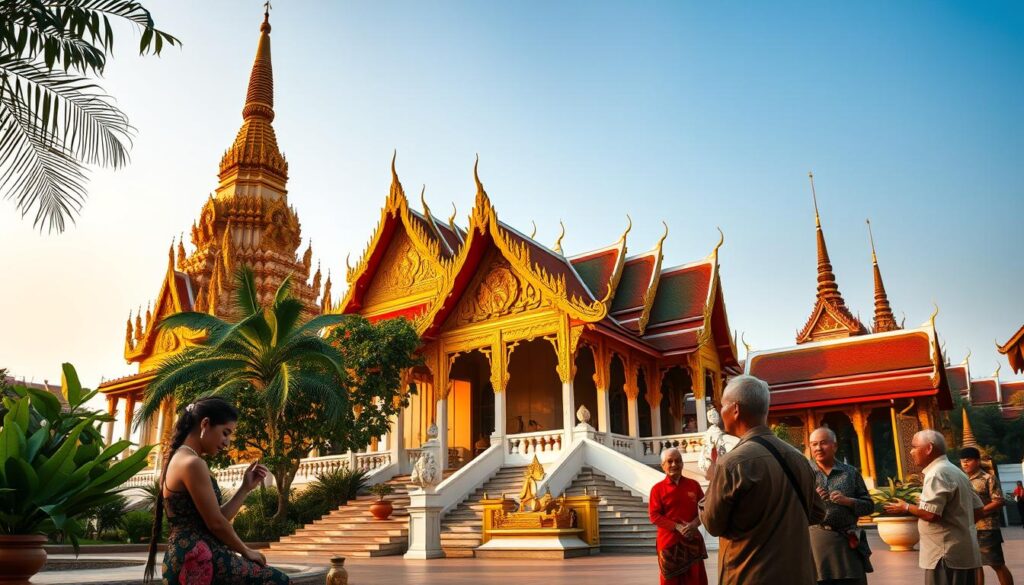
Greeting Etiquette
In Thailand, the traditional greeting is called a “wai.” To wai, place your palms together at chest level and bow slightly. The higher your hands, the more respect you show.
Be careful with your body language when meeting locals. Avoid touching or pointing at people or sacred objects, as it’s seen as rude.
Dress Appropriately
Thailand is a conservative country. Dressing modestly is important, like when visiting temples or cultural events. Cover your shoulders and knees as a sign of respect.
Here are some tips for dressing right in Thailand:
- Wear lightweight, breathable clothes that cover your skin
- Avoid revealing or provocative clothing
- Remove your shoes and socks when entering temples or homes
By understanding and respecting Thai culture and customs, you’ll have a better trip. Remember, being mindful of local traditions is key to a successful visit.
Planning Your Itinerary
Thailand has many places to see, from busy Bangkok to peaceful islands. Planning well is key for a great trip. With so much to do, it’s easy to get lost in planning.
Here are some tips for planning your Thailand itinerary.
Popular Destinations to Include
Thailand has many famous spots you shouldn’t miss. Some top places include:
- The bustling streets of Bangkok, where you can explore the Grand Palace and Wat Phra Kaew.
- The idyllic beaches of Phuket, known for their crystal-clear waters and lively night markets.
- The cultural hub of Chiang Mai, famous for its ancient temples and vibrant festivals.
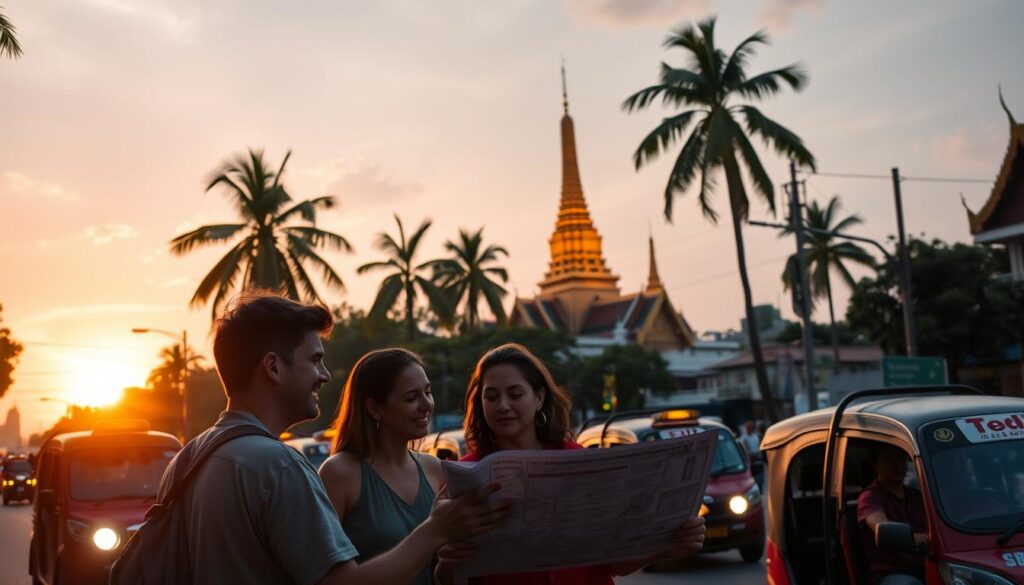
Balancing Activities vs. Relaxation
It’s tempting to fill your days with activities. But remember to relax too. Thailand offers both exciting adventures and peaceful moments.
Try to mix your days between doing things and relaxing. For example, spend a day at ancient ruins, then enjoy a calm boat ride.
Allowing Flexibility for Discovery
Even with a detailed plan, leave room for surprises. Some of Thailand’s best moments come from unexpected finds, like local festivals or hidden spots.
By mixing planned activities with free time, you’ll enjoy your trip more. You’ll also discover the joys of traveling in Thailand.
For your first trip, seven to ten days is a good amount of time. If you’re short on time, focus on one area, like Bangkok or Chiang Mai.
Navigating Transportation Options
Getting around Thailand is easy with its wide range of transport options. Whether you’re in busy Bangkok, relaxing in Phuket, or seeing Chiang Mai’s culture, knowing how to get around makes your trip better.
Public Transport: Pros and Cons
Public transport in Thailand is cheap and works well. You can use buses, trains, or boats to see local life in different ways.
- Pros:
- Affordable
- Extensive network
- Opportunities to interact with locals
- Cons:
- Can be crowded
- Limited English signage
Renting a Scooter: Safety Tips
Renting a scooter lets you explore at your own speed. But, safety is key.
- Wear a helmet
- Follow local traffic rules
- Be aware of road conditions
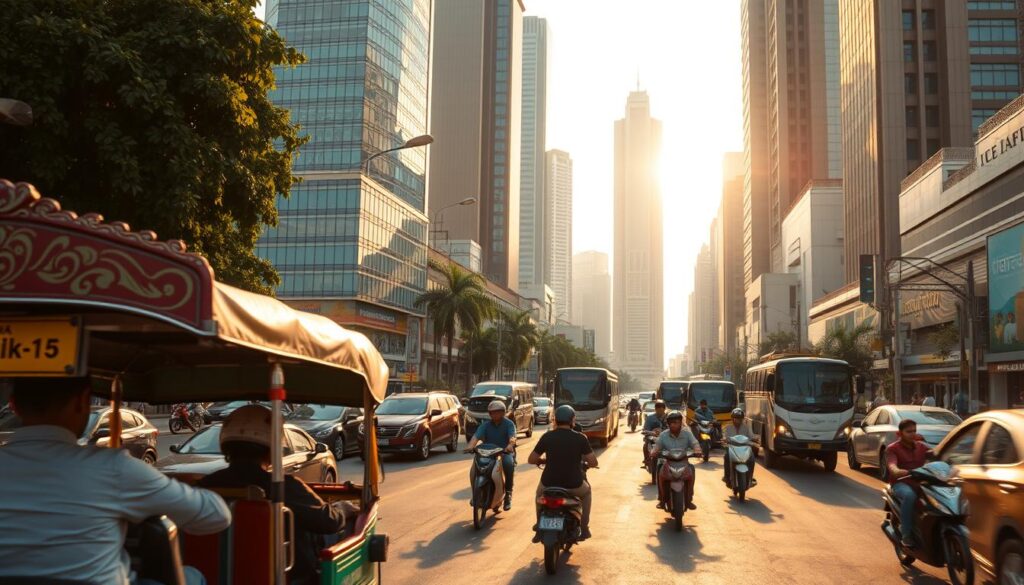
Using Taxis vs. Ridesharing Apps
Taxis and ridesharing apps are good for moving around Thai cities. Knowing the difference helps you choose wisely.
- Taxis are easy to find but may not always use meters.
- Ridesharing apps have clear prices and can be booked ahead.
Packing Essentials for Thailand
Before you start your Thai adventure, think about what to pack. Thailand’s weather and culture are different, so it’s important to pack right. This ensures a comfortable and respectful trip.
Weather Considerations
Thailand’s weather changes a lot throughout the year. The south has a tropical monsoon climate. The north has a cooler climate with colder winters.
- Lightweight clothing for hot weather
- Rain gear for unexpected showers
- Warm layers for cooler evenings in the north
Must-Have Items for First-Time Travelers
For a smooth and enjoyable trip, remember to pack:
- Comfortable shoes for exploring
- Insect repellent to protect against mosquitoes
- Power adapter for charging your devices
- Reusable water bottle to stay hydrated
Cultural Sensitivity in Clothing
When visiting temples or cultural events, dress modestly. Cover your shoulders and knees as a sign of respect.
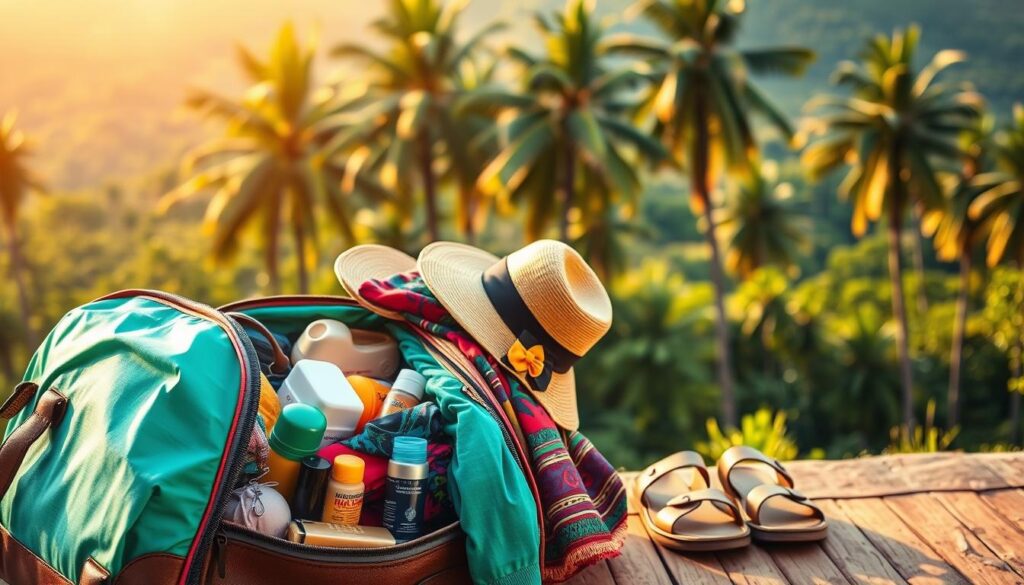
Currency and Budgeting Tips
To enjoy Thailand without financial worries, it’s key to understand the Thai baht and budgeting. Knowing the local currency and how to manage your money can make your trip better.
Understanding the Thai Baht
The Thai baht is Thailand’s official currency. It’s smart to know the current exchange rates before you go. You can find the latest rates online or on a mobile app.
Best Practices for Currency Exchange
Here are some tips for exchanging your money for Thai baht:
- Exchange some money before arriving in Thailand for your first expenses.
- Use ATMs to get cash as needed; they often have good exchange rates.
- Avoid exchanging money at airports or tourist spots, as rates might not be good for you.
Budgeting for Activities and Dining
Thailand has many activities and dining options for all budgets. Here are some budgeting tips:
- Street food is tasty and cheap, with meals starting at 100 THB (£2.50).
- Public transport is cheap, with fares from 20 THB (£0.50) for one trip.
- Save extra for experiences like visiting temples or taking a cooking class.
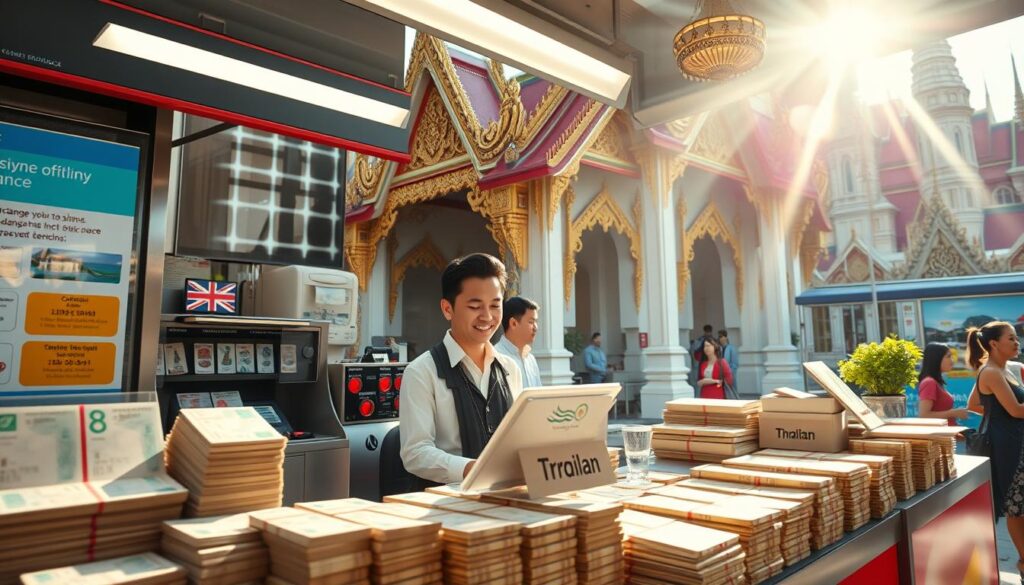
Costs in Thailand can change a lot. While transport is cheap, a coffee or beer can cost as much as a street food meal. Being careful with your spending and having a budget can help you enjoy your trip more.
Learning Basic Thai Phrases
Many Thais speak some English, but learning basic Thai phrases shows respect. This simple act can make your trip better. It lets you connect more with locals and understand Thai customs better.
Essential Phrases for Communication
Learning a few key Thai phrases can make your trip more fun. Start with greetings like “Sawatdee” (hello) and “Khop Khun Krap” (thank you). Knowing “Chai” (yes) and “Mai Ow Hai” (excuse me) is also very useful.
- Basic Phrases:
- Hello: Sawatdee
- Thank you: Khop Khun Krap
- Yes: Chai
- Excuse me: Mai Ow Hai
- Sorry: Khhor Toht
Helpful Apps for Language Learning
Today, many apps help you learn Thai quickly. Some top picks are:
- Duolingo: A simple app with Thai language courses.
- iTalki: Helps you find language tutors for personal lessons.
- Google Translate: Translates Thai text and speech in real-time.
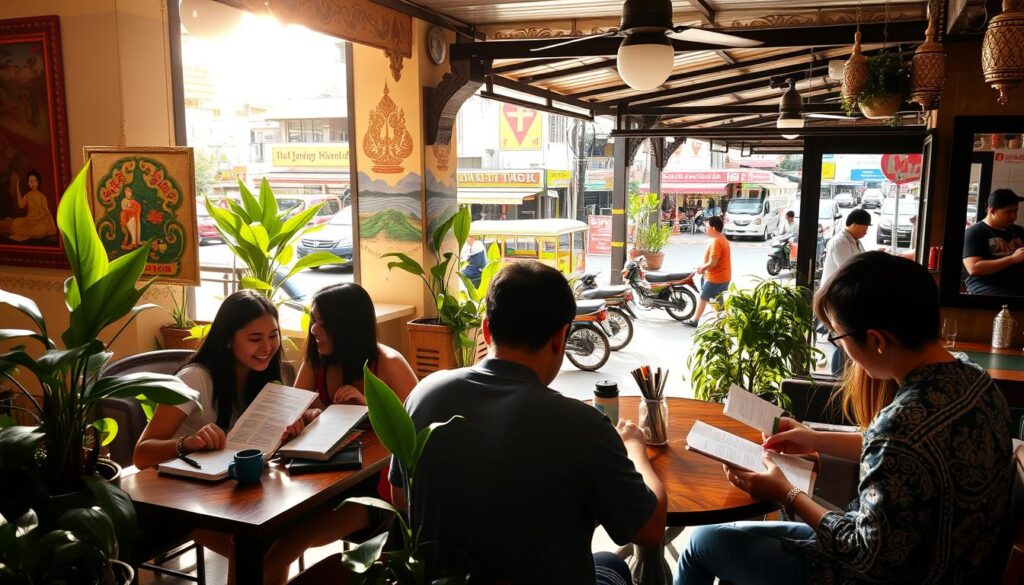
With these tools, you can learn basic Thai phrases before your trip. This will make your journey even more rewarding.
Food and Dining Etiquette
Visiting Thailand is a treat for food lovers. The street food scene is a culinary adventure. As you wander Bangkok’s streets, you’ll smell the delicious dishes being made right in front of you.
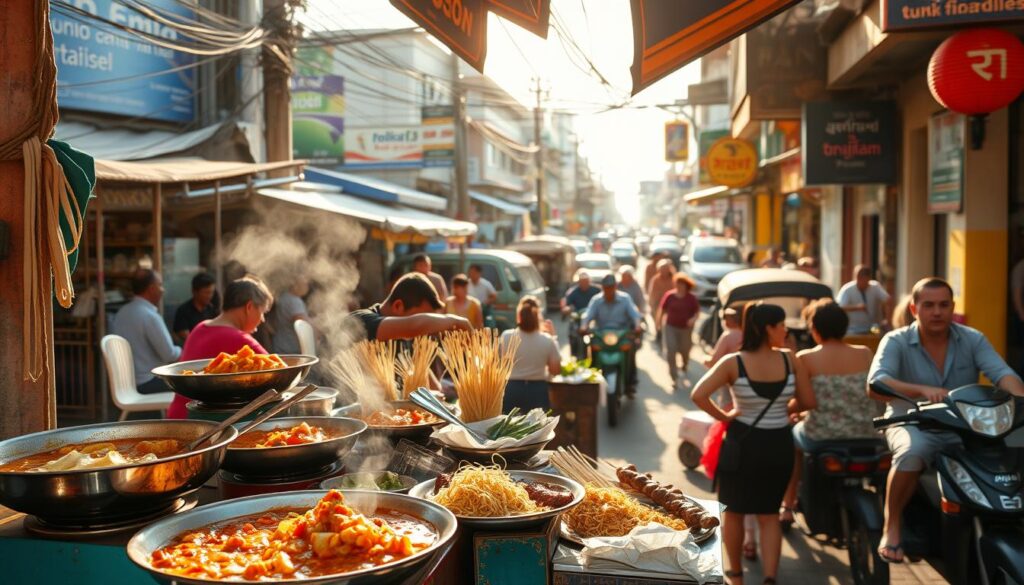
Street Food: What to Try
Thai food is known for its bold flavours and spices. Street food is the best way to taste Thailand’s real flavours. You must try Pad Thai, a mix of sweet, sour, and savoury noodles. And don’t miss Tom Yum soup, a spicy soup with prawns or chicken.
Other dishes to try are Som Tam (papaya salad) and Khao Soi, a curried noodle soup from Northern Thailand. For a sweet treat, try durian or mango sticky rice.
Knowing What to Avoid
Thai street food is mostly safe, but be careful. Eat at busy stalls or restaurants. This means the food is fresh and eaten quickly.
Don’t eat raw or undercooked meat. Be careful with raw veggies that might not be clean. If you’re sensitive, skip spicy or oily foods.
Tipping Culture in Thailand
Tipping in Thailand is not required but is nice for good service. In restaurants, 10-20 THB (0.25-0.60 USD) per person is enough. For street food, tipping is not expected but is welcome.
For tour guides or taxi drivers, 50-100 THB (1.50-3.00 USD) is a kind gesture. Remember, tipping is a way to thank for good service, but it’s not necessary.
Staying Safe During Your Trip
Thailand is generally safe for visitors, but it’s wise to take precautions. Knowing what to watch out for can make your trip better.
Recognising Scams Commonly Encountered
Scams in Thailand can range from too-expensive tuk-tuks to credit card theft. Staying alert can help you dodge these traps.
- Watch out for overly friendly locals with ‘deals’ that seem too good to be true.
- Stick to reputable taxi services or apps, and never take an unlicensed tuk-tuk.
- Be careful with ATMs, covering the keypad when you enter your PIN.
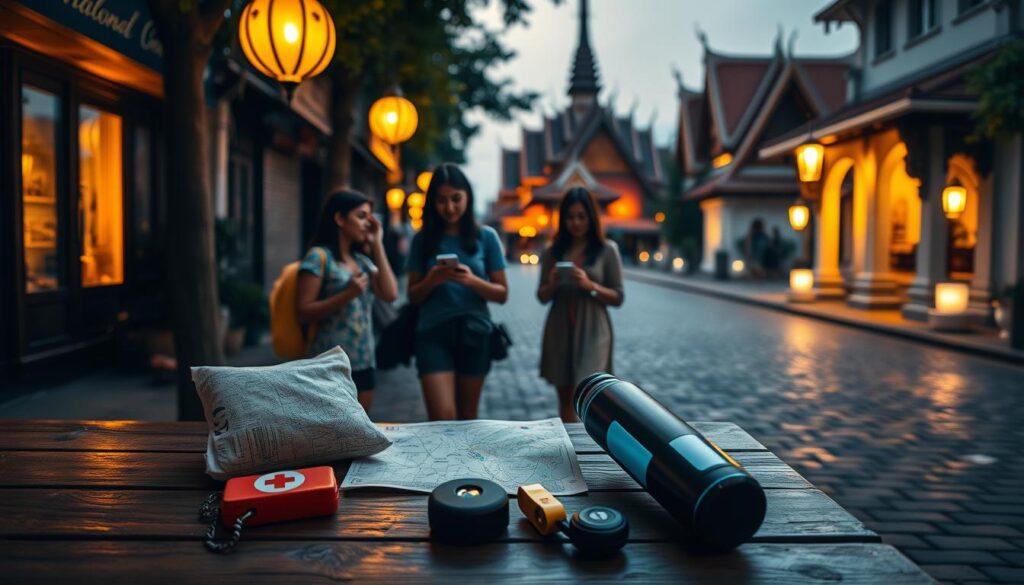
Emergency Contact Information
Having the right emergency contacts can save you. Make sure you have:
- The embassy or consulate of your country in Thailand’s contact details.
- Important phone numbers like the tourist police (1155) and local emergency services.
- A fully charged phone with a local SIM or an international plan.
Health Precautions to Consider
Thailand’s climate and food can sometimes cause health issues. To stay well:
- Drink bottled or filtered water and avoid ice in drinks from street vendors.
- Make sure you’re up-to-date with all needed vaccinations before you go.
- Be careful with street food, choosing stalls that are busy and serve a lot.
By knowing about these risks and taking simple steps, you can greatly lower the chance of problems on your Thailand trip.
Respecting Wildlife and Nature
Thailand’s biodiversity is a treasure. As a visitor, you can help preserve it. The country’s natural spots, like forests and beaches, are full of unique plants and animals.
Responsible Tourism Practices
When in Thailand, it’s key to practice responsible tourism. This means respecting wildlife, not littering, and backing local conservation. For example, in national parks, stay on paths and don’t feed animals. These actions help protect them.
- Choose tour operators that follow eco-friendly practices and support conservation.
- Be mindful of your water usage, specially in areas where water is scarce.
- Support local communities by buying their products and services.
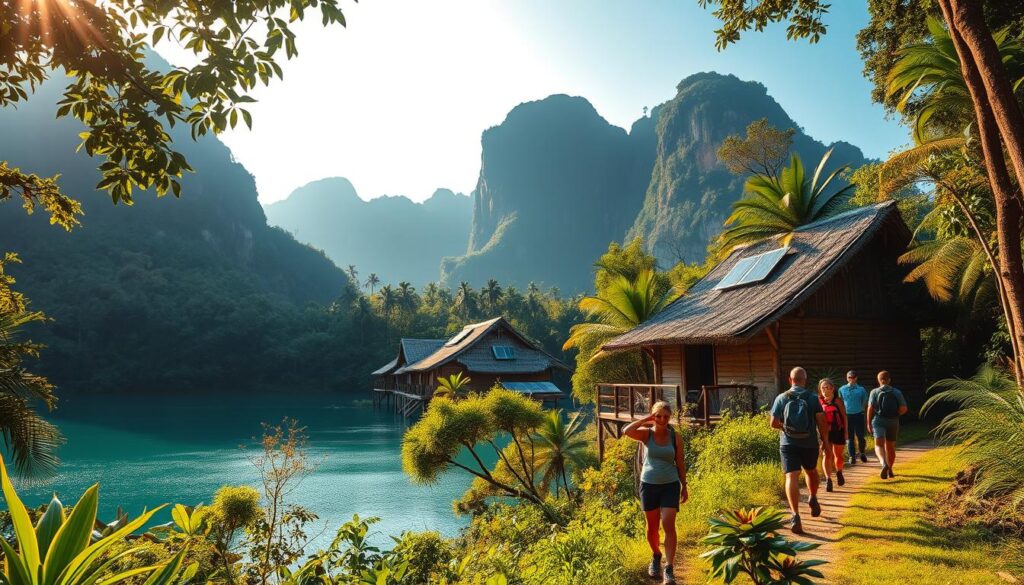
Supporting Eco-friendly Initiatives
Thailand is now home to more eco-friendly projects. These aim to protect its beauty and wildlife. By supporting these, you help with sustainable tourism. Look for projects on reforestation, marine conservation, and wildlife protection.
- Join volunteer programs that help with conservation.
- Visit eco-lodges and environmentally friendly places to stay.
- Tell others about the need for conservation.
By choosing wisely and traveling responsibly, you can help Thailand’s nature thrive for future generations.
Making the Most of Your Experience
Exploring Thailand can be truly rewarding if you dive into the local culture. Talking to locals gives you a peek into the country’s history and everyday life.
Connecting with the Community
Visit local markets, join a cooking class, or take part in a community event. These activities help you make friends and understand Thai traditions better.
Experiencing Local Festivals
Thailand’s festivals, like Songkran and Loy Krathong, are unforgettable. Joining in these celebrations lets you truly experience the culture and make memories that last.
Creating Lasting Memories
Be adventurous and try new things on your trip. From street food to ancient temples, embracing the local culture makes your journey special.
